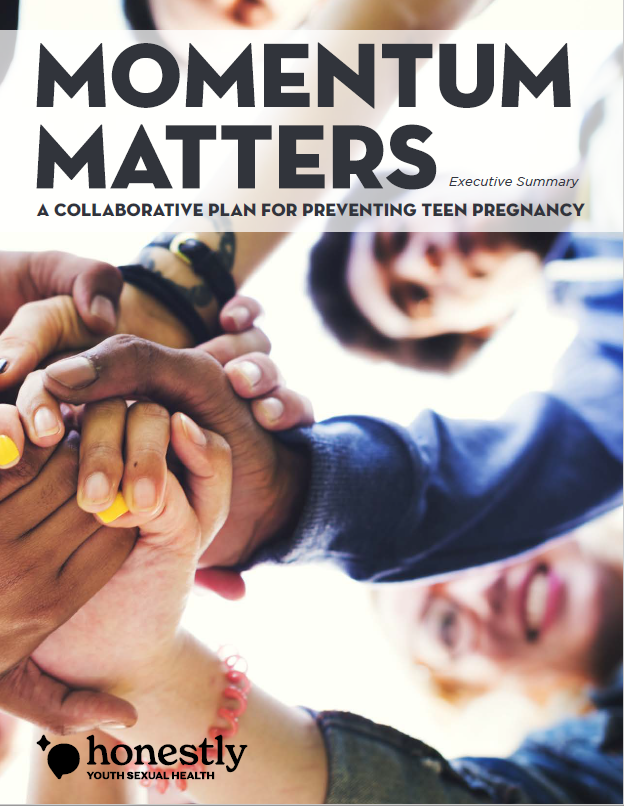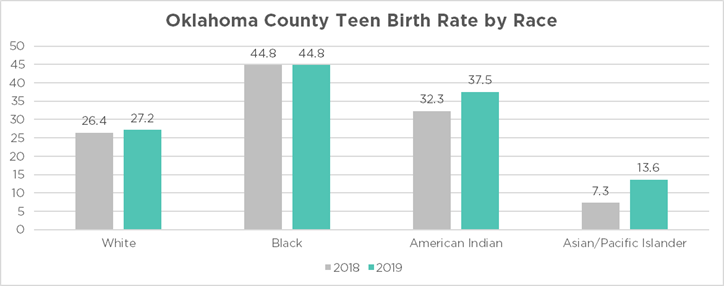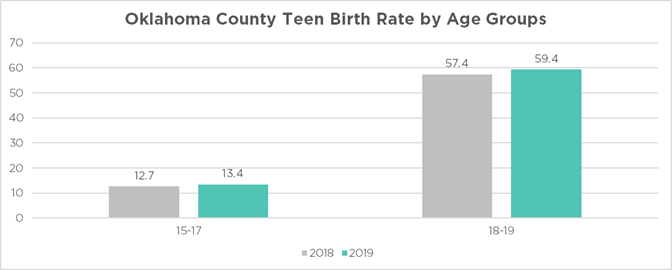A collaborative plan for preventing teen pregnancy
The Collaboration’s history is rich with tenacity, hard work, and a driving passion to improve the lives of young people in central Oklahoma. Despite impactful and inspiring progress, Oklahoma has the 4th highest teen birth rate in the nation, and Oklahoma County still holds the highest number of teen births in the state.
In 2019, honestly (formerly Thrive) embarked on a strategic planning process that allowed us to listen to and learn from experts and residents of our community. Community voices, combined with a local and national data and policy review, guided the creation of the Collaboration’s next steps and informed our new common agenda, inclusive of a new goal to:
Reduce Oklahoma County’s Teen Birth Rate by an additional 25% by 2025
Read the Momentum Matters Executive Summary

To dig deeper into our plan and learn how you can be a part of this movement, check out the Momentum Matters executive summary, appendices (listed below) and evaluation plan. Together, we can continue to write Oklahoma County’s success story.
Strategic Objectives
The direction of honestly and the Collaboration is headlined by three key priority areas: inform, connect, engage. These strategic objectives provide the backdrop, synergy, and context of why collaboration matters, and how ALL of us can be change agents for youth.
Priority 1: Inform
Empower all young people, and the caring adults in their lives, by providing medically accurate, age-appropriate sexual health information.
Priority 2: Connect
Facilitate relationships-within our Collaboration and the broader community-to ensure young people access the health care services, resources, and programs they need.
Priority 3: Engage
Create an inclusive, community-wide movement by compelling meaningful participation and investment to support adolescent sexual health.
In order to further facilitate the work of the comprehensive plan and priority areas, the Collaboration’s Advisory Council prioritized three strategic objectives that currently drive the Collaboration’s Action Teams. Action Teams are committees focused on specific needs and tasks that further the common agenda.
Youth Engagement Action Team: working to bring youth voice and action to systems-level needs, decisions, and solutions for the Collaboration.
Robust Referral System Action Team: working to build a robust system of supportive relationships and linkages between medical professionals, educators, and community-based organizations ensuring that youth are able to access and receive the contraceptive method of their choice.
Priority Populations Action Team: working to reach and engage new partners that serve, and represent, priority populations in high-need zip codes.
Want to get involved in an Action Team? Fill out the Change Agent Inventory and let us know you are interested in learning more!
Check out all the details involved with these strategic objectives in our comprehensive plan Momentum Matters and Supplemental Guide.
Health Equity
Teen pregnancy is an issue that impacts everyone, but data clearly shows that disparities in teen birth rates persist in Oklahoma County and across the country. Our Collaboration is committed to focusing on the health disparities and inequities that exist locally, including those that exist by age, race, and geography, with additional attention paid to identified priority populations.

Disparities by race and ethnicity:
In Oklahoma County, there are significant disparities in the teen birth rate by race. Black teens have the highest birth rate followed by American Indian, White, and Asian Pacific Islanders. However, between 2018 and 2019, the teen birth rate increased for all races except Black. Asian/Pacific Islanders showed the largest increase; yet, it should be noted that this increase only represented eight more live births than the previous year (5 in 2018 to 13 in 2019).
Our Collaboration is dedicated to developing intersectional approaches that address the social determinants that contribute to racial/ethnic disparities in the teen birth rate. We are working to create change through partnering with organizations that are doing the important work of addressing health inequity, developing strategies co-created with members of the communities most affected, and building our capacity to more effectively target community-specific interventions.

Disparities by age:
In Oklahoma County, there are significant disparities by age, with 18-19 year olds being over 4 times more likely to give birth. Our Collaborative is committed to developing creative strategies to address age-related disparities in the teen birth rate, including working with organizations who work with this population.

Disparities by geography:
Our Collaboration has identified five priority zip codes using a three-factor assessment. Each of the priority zip codes:
- have high teen birth rates;
- score poorly across several related socio-economic factors closely related to teen pregnancy; and
- have a sufficient population of 15-to 19-year-old females, increasing the likelihood of impact with successful interventions.
Based on this assessment, we identified the following zip codes as high priority geographic areas for targeted interventions: 73108, 73109, 73119, 73127 and 73129.
Our Priority Populations Action Team is conducting listening sessions in the priority zip codes. The information collected will be used to:
- Create robust zip code profiles that create a picture of the assets and resources in these communities; and
- Identify community leaders and organizations who will partner with the Collaboration to create action plans and strategies to address the needs in these communities.
Disparities among priority populations:
The U.S. Office of Population Affairs has identified populations of youth who may need special support related to their health care and development.
- children of immigrants and refugees
- homeless youth
- youth in foster care
- youth in the juvenile justice system
- LGBTQ+ youth
- youth with disabilities
Our Collaboration consists of community partners across Oklahoma County who represent all of our priority populations. Through these partnerships, we are ensuring that our work prioritizes these youth.
Equity Committee
We understand the needs of all young people are not the same. While our Collaboration is built on a recognition that diversity, equity, and inclusion must inform our work, in the summer of 2020, the murders of George Floyd, Ahmaud Arbery, and Briana Taylor coupled with a Global pandemic that highlighted many existing inequities, helped us see a need to significantly increase our efforts in this area. We started by releasing an anti-racism statement that highlighted actions that we will take to address inequity in our community. Among these strategies was the creation of a committee to develop partnerships and strategies and to serve as a group that can anticipate and respond to changes in our community and the country.
The purpose of the Equity Committee is to:
- Develop guiding principles related to equity to be used as a guide for all teams, projects, programs, data and evaluation measures, and policies.
- Develop training recommendations for honestly staff, the Collaboration and the community to increase the understanding and application of equitable principles at every level.
- Identify strategic partnership opportunities with organizations and individuals already engaged in the work of advancing equity and promoting anti-racism.
- Work to build a committee culture that is based on co-creation, collaboration, and shared power.
- Ensure that all committee recommendations are medically accurate and trauma-informed.
- Hold the Collaboration and its leadership groups and action teams accountable for implementing recommended equity strategies
The Guiding Principles for the Equity Committee are:
- Equity forms the foundation of our work.
- We will confront the most complicated and difficult issues surrounding anti-racism and equity, rather than only focusing on the easiest issues to address.
- Identify strategic partnership opportunities with organizations and individuals already engaged in the work of advancing equity and promoting anti-racism.
- Identities are intersectional and complicated.
- Voices and perspectives of those with lived experience (context experts: youth and caregivers) guide our recommendations and the committee’s work.



